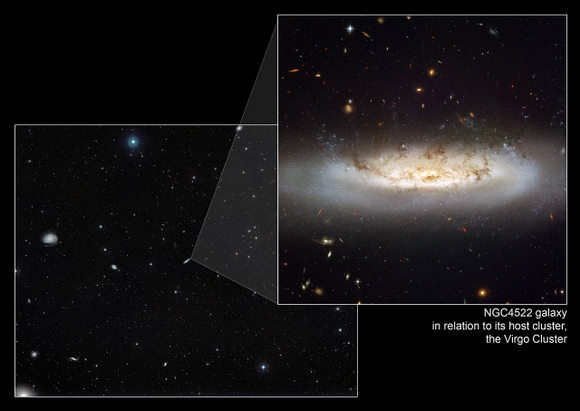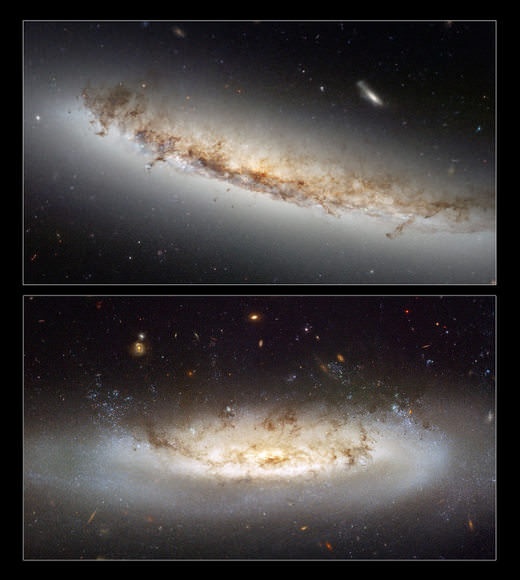[/caption]
Strange forces of nature are stripping away gas from galaxies in the Virgo cluster. An extremely hot X-ray emitting gas known as the intra-cluster medium permeates the regions between galaxies inside clusters and, as fast moving galaxies whip through this medium, strong winds tear through galaxies distorting their shape and even halting star formation with a process known as “ram pressure stripping.” Hubble spied two galaxies “losing it” to these forces.
Ram pressure is the drag force that results when something moves through a fluid — much like the wind you feel in your face when bicycling, even on a still day — and occurs in this context as galaxies orbiting about the centre of the cluster move through the intra-cluster medium, which then sweeps out gas from within the galaxies.
The two galaxies — NGC 4522 and NGC 4402 – were imaged by the old Advanced Camera for Surveys on Hubble before it suffered from a power failure in 2007. Astronauts on Servicing Mission 4 in May 2009 were able to restore ACS during their 13-day mission.

The spiral galaxy NGC 4522 is located some 60 million light-years away from Earth and it is a spectacular example of a spiral galaxy currently being stripped of its gas content. Astronomers estimate the galaxy is moving at more than 10 million kilometers per hour, and its rapid motion within the cluster results in strong winds across the galaxy as the gas within is left behind. A number of newly formed star clusters that developed in the stripped gas can be seen in the Hubble image.
The image provides a vivid view of the ghostly gas being forced out of it. Bright blue pockets of new star formation can be seen to the right and left of centre. The image is sufficiently deep to show distant background galaxies.
The image of NGC 4402 also highlights some telltale signs of ram pressure stripping such as the curved, or convex, appearance of the disc of gas and dust, a result of the forces exerted by the heated gas. Light being emitted by the disc backlights the swirling dust that is being swept out by the gas. Studying ram pressure stripping helps astronomers better understand the mechanisms that drive the evolution of galaxies, and how the rate of star formation is suppressed in very dense regions of the Universe like clusters.
Source: Hubble Science Center


Last nights The Universe briefly talked about this, but I was a bit confused. This filled in the gaps, thanks for posting it.
Two recent papers have published regarding ram pressure stripping of these galaxies. The first ( http://arxiv.org/PS_cache/arxiv/pdf/0809/0809.5178v1.pdf ) deals with NGC 4402 and has many great explanatory diagrams of the encounter with the Virgo Cluster ICM.
OOOpps, that link above is to NGC 4522. The other paper refers to 5 tidally stripped galaxies in the Virgo Cluster, including NGC 4522 and NGC 4402 ( http://arxiv.org/PS_cache/arxiv/pdf/0802/0802.3678v1.pdf ). Those HST images are surely the best optical light pictures of these infalling galaxies. Ram pressure rules in dense clusters!
On the highest resolution shots (i.e. largest files) note the profuse amount of HII and OB clusters as well as OB giants visible along the bluish side of these galaxies as they interact with the Intra Cluster Medium. Just one more mechanism for stellar formation and galaxy morphology in galaxy clusters as a whole.
When I was a little younger I never would have guessed that the cores of galaxy clusters were basically stellar graveyards where galaxies go to grow old to die earlier than they would have otherwise. Interesting stuff, and the images are beautiful! (One of the is now my background desktop image at work)